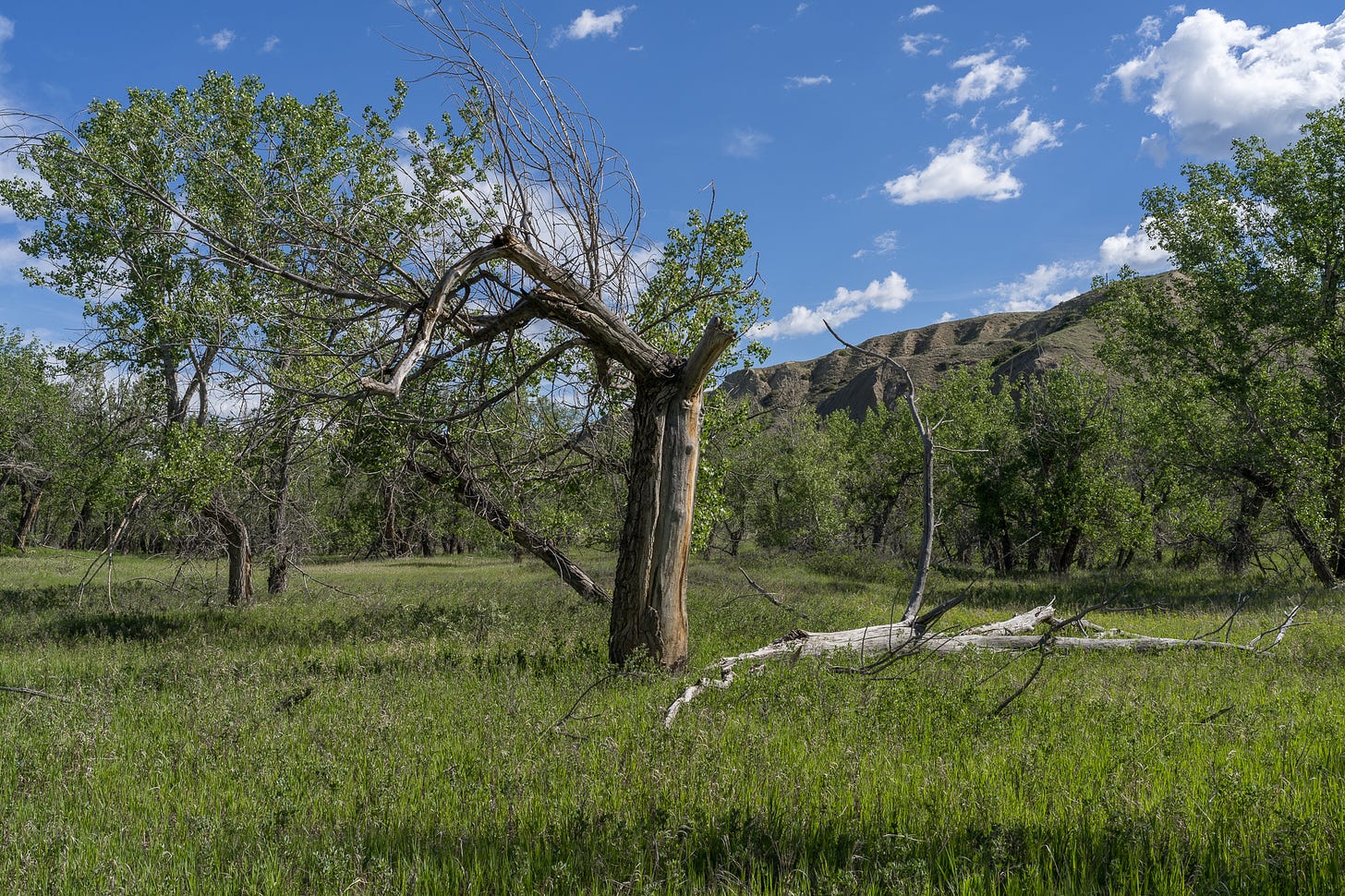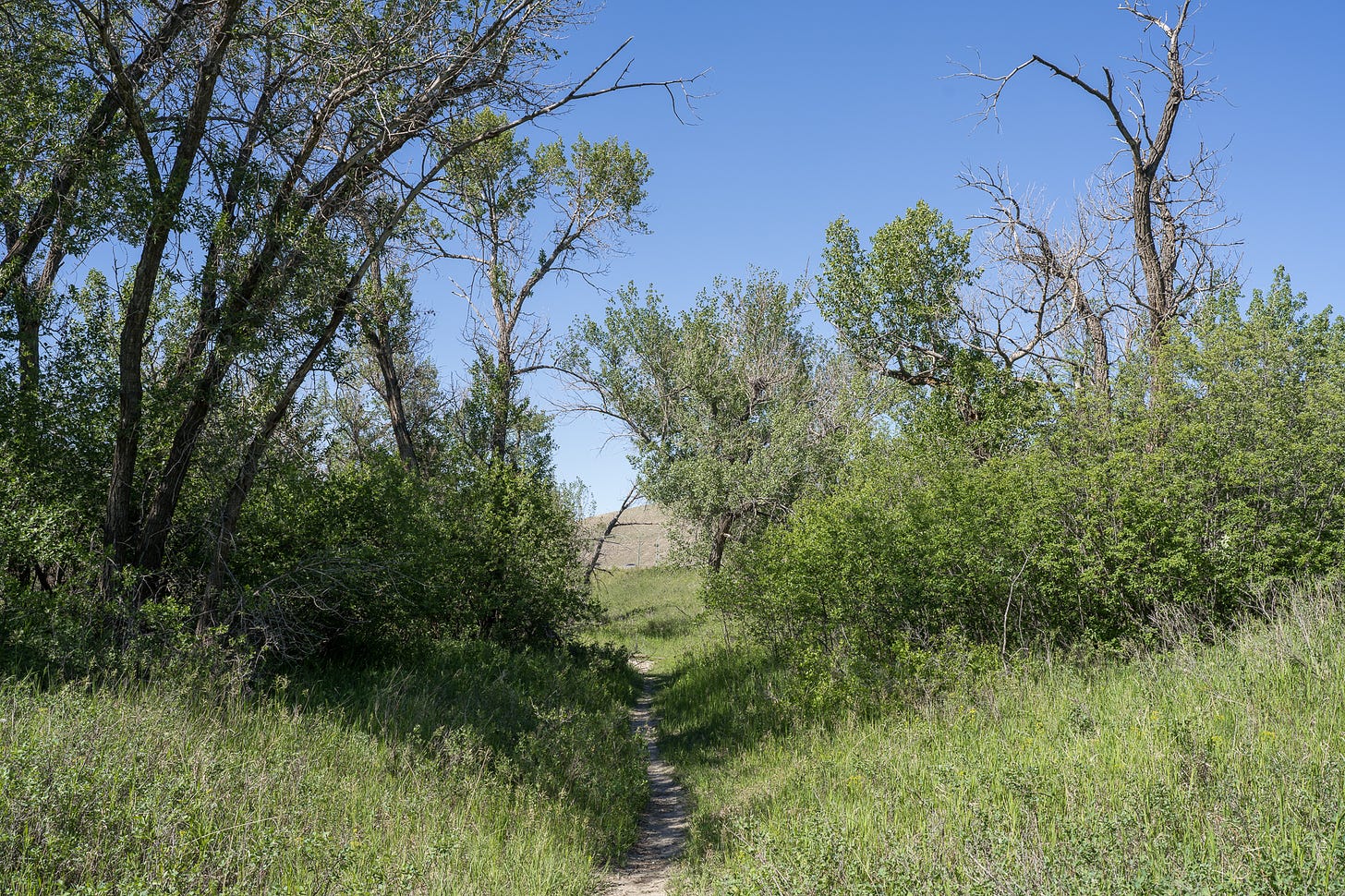Alberta Cottonwoods
“…But it is summer. Useless cottonwoods do not crack in cold.
They've thrown a storm of pith and down across lawn and screens.”
Art Homer
Cottonwood Blues
Cottonwoods, more than any tree I know, cut across the sky and spread out like a million tiny rivers. Very early in their lives, they stand majestically in one place but sooner than most trees they fall down of their own accord in what looks to be despair. Today they are less than useful, all you can do with them is make paper pulp and other products calling for pulp. They do not make useful tables, chairs or telephone polls. Yet my eye is always pulled toward them. In their small groups, usually following a river or culvert, they remind me of a battlefield with the wounded lying about everywhere, randomly scattered. But visually, they are just hard to ignore.
My photos of cottonwoods were taken in a small valley, home of Indian Battle Ground Park, in Lethbridge, Alberta. Most people with a camera go there to photograph High-Level Bridge / Lethbridge Viaduct, the longest & highest trestle bridge in the world. In some of my photos you may see it here and there, far up in the sky from the valley floor, just visible through the branches and summer leaves of the cottonwoods.
When I got to Indian Battle Park it was the cottonwoods that counted for me. The Lethbridge River Valley is one of only a few places in the world where three species of cottonwood trees are found together. Walking through the cottonwoods there is a sense of emptiness. A quiet that feels of isolation and constant change in the trees rising and falling so quickly, a timelessness.
Indian Battle Ground Park. That’s the name of one section of the valley, a name the city council has tried but failed to change. They wanted to change it to something with the word peace in it, like World Peace Park or something similar. It was here in Indian Battle Ground, before it was a park, the last inter-tribal conflict in North America occurred in 1870 between the Blackfoot and the Cree in an area extending from near the original site of Fort Whoop-Up down in the valley, past the present location of the University of Lethbridge which can be seen on the edge of the hill, into the area now called Indian Battle Coulee and across the river to Indian Battle Park. The battle was won by the Blackfoot, who gave the name Asinaawa-iitomottaawa, or “Where We Slaughtered the Crees,” to the general locality. The Blackfoot seemed to be more direct with their naming of the area.
If you have lived very long in the mid or southwest, generally in the Great Basin and surrounding areas, you might know that cottonwoods have long been associated with spirituality. For many indigenous peoples, cottonwoods have a deep cultural significance and are considered sacred. In Navajo culture, for example, cottonwood is believed to have healing powers and is used in traditional ceremonies.
Cottonwoods are seen as a symbol of renewal and new beginnings. This is because they are one of the first trees to sprout from the ground in spring, often emerging before other vegetation. They are also some of the fastest-growing trees, reaching maturity in as little as 10 years. The cycle of growth and renewal embodied by cottonwoods speaks to a universal human experience of spiritual growth and transformation. Yes, life and death.
I first took note of someone else ’s photography focused on cottonwoods in the work of Robert Adams. His black-and-white images of them populate several of his books. Trees have been a subject of lifelong engagement for Robert Adams, and no species has enthralled him more than the cottonwood. He knew they were revered by the Plains Indians, and as he moved westward himself he noted how native cottonwoods animate the landscape, but their thirst for water and lack of commercial value have made them common targets for removal by agribusiness and housing developers. Adams photographed them over and over throughout the thirty-five years he lived in Colorado. His trees are seen as symbols of the resilience and endurance of the natural world. In his images, the cottonwoods are depicted as grand and majestic, yet also gentle and nurturing. Looking at the images you crave their shade. They are a constant presence in the landscape, and because of their tendency to be grouped in areas where trees of different ages stand near one another, they are seen as representing the timelessness of nature.
The significance of cottonwoods in Robert Adams' work extends beyond their physical appearance. Adams saw the cottonwoods as a way to connect with the history of the American West. Adams sought to capture the historical significance of these trees and to pay homage to the cultures that have long been intertwined with the landscape.
In addition to their historical significance the natural world the cottonwoods are in is a source of inspiration and contemplation, and the cottonwoods are a particularly powerful symbol of this connection. In his images, the trees are often depicted in a peaceful, serene setting, surrounded by other elements of the natural world. These images evoke a sense of calm and tranquillity. His newest book, American Silence, has a significant essay about Adams and the importance of spirituality to his work. It’s an unexpected joy to read his simple words and actions rather than philosophic essays about Heidegger in a photographic catalogue. Especially from someone associated with the New Topographics movement and “objective” photography (although Adams state directly that he doesn’t want to be considered an “objective” photographer.
Adam’s monochrome images are in contrast to my own use of colour when photographing cottonwoods. The colour can take away some of the calm and quiet, but for my eye, the colour images are more reflective of the true nature of the trees as we experience them. The subtle colouring and shading of the trunks and the differences evident in their canopy of leaves make for a more true-to-nature image. Adams says that art, the photographer specifically, “observes life so accurately that he or she is able to find things that we can recognize typical and believable.” To me that certainly sounds like “objective” photography, and certainly similar to the aim of many photographers who we would associate with the New Topographics and Dusseldorf Schools of photography. Still, Adam’s cottonwoods are, to me, iconic, meaningful, believable and beautiful due to their overall simplicity.
Books I mentioned:
American Silence, The Photographs of Robert Adams. Aperture Books
Cottonwoods, Robert Adams
Originally published by the Smithsonian in 1994 as a part of the series “Photographers at Work,” this new edition of “Cottonwoods” has been expanded and enlarged
A video showing the first edition of Adams Cottonwoods:
My work can be found at:















Mostly, I would say, he see's his work related to traditional forms of "beauty" and this deep spiritual sense he has, described in some good detail in the book's essay, is overwhelming. The term "objective" relates to all those things you complain about when I mention the issue of style. He writes so often about the value of art and I think that just conflicts with this objective-Dusseldorf School mentality coming out of conceptual art.
An interesting and well-informed essay, as I have come to expect from you, Jim. I’d be interested to hear more about why Adams does not want to be considered an objective photographer. I guess if I finish the introduction to American silence, I would probably know :-)